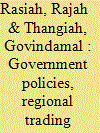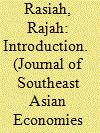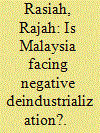|
|
|
Sort Order |
|
|
|
Items / Page
|
|
|
|
|
|
|
| Srl | Item |
| 1 |
ID:
165383


|
|
|
|
|
| Summary/Abstract |
Since its formation in 1967, the Association of Southeast Asian Nations (ASEAN) has progressed to become an economic powerhouse. From a loosely formed grouping in the 1960s, its members have since undergone massive integration. A key motive of the Association is to transfer government and public services onto a technology platform, termed e-government. An important concern is whether e-governance can reduce corruption and stimulate sustainable development. Using traditional governance measures and e-governance indices, this paper analyses the state of governance and corruption in ASEAN. While the deepening of e-governance — via government and public participation — has raised the potential for improving good governance practices, that in itself can be counterproductive as socioeconomic agents could broaden corrupt practices by appropriating its public-good-like characteristics. Hence, ASEAN governments have to implement changes in their communications strategies and feedback mechanisms, remove barriers blocking the spread and use of information technology, and promote a collaborative environment with civil society organizations, while considering the use of the “carrot and stick” approach to improve good governance.
|
|
|
|
|
|
|
|
|
|
|
|
|
|
|
|
| 2 |
ID:
180685


|
|
|
|
|
| Summary/Abstract |
Human immunodeficiency viruses (HIV) counselling and testing (HCT) plays a major role in the continuum of HIV programmes in Nigeria. However, HIV-related stigma (STGM) poses a serious threat to its success. Consequently, a cross-sectional study was carried out to examine whether STGM mediates the relationships between the explanatory variables (HIV-related knowledge, HIV transmission misconception (MSHIV), and perceived seriousness of HIV/acquired immune deficiency syndrome (AIDS)), and the outcome variable (HCT service utilization). The mediation analysis was undertaken using data from 768 individuals collected through convenience sampling in the Local Government Areas of Alimosho, Ikorodu, and Surulere of Lagos state, and deploying partial least squares–structural equation modelling. The results show that STGM played a mediating role in the relationship between MSHIV, perceived seriousness of HIV/AIDS, and HCT utilization. These findings offer wide ramifications for the intensification and enforcement of Nigeria’s HIV/AIDS Anti-Discrimination Act 2014 to eradicate stigma, which is important to enhance uptake of HCT to achieve the United Nations’ 90-90-90 HIV targets by 2020.
|
|
|
|
|
|
|
|
|
|
|
|
|
|
|
|
| 3 |
ID:
154534


|
|
|
|
|
| Summary/Abstract |
Several governments, including Malaysia's, have promoted small and medium enterprises (SMEs) for the socio-economic benefits such policies bring. Since the 1990s, Malaysian SMEs have progressed to take advantage of the exporting opportunities opened up by regional trading arrangements (RTAs). Using the electronics industry, which is prevalent in the manufacturing sector of Malaysia, this paper seeks to analyse the relationships between size and technological and performance variables. While foreign electronics firms in Malaysia have been thoroughly studied in the past, this paper focuses on national firms, which have been understudied thus far. SMEs show stronger participation in exports to ASEAN countries than large firms. Size did not matter in the intensity of use of technological capability variables. The government's initiatives to support them with ICT infrastructure, and trade promotion may have been successful. Also, RTAs show significant importance as the relationship between firms using them and intensity of exports to ASEAN and Northeast Asia is positive and strong. Also, while the incidence of participation in in-house R&D (IHRD) and training expenditure in payroll (TEP) is higher among firms that have used RTA instruments compared to firms that have not, firm size was not significant.
|
|
|
|
|
|
|
|
|
|
|
|
|
|
|
|
| 4 |
ID:
165378


|
|
|
| 5 |
ID:
165379


|
|
|
| 6 |
ID:
108798


|
|
|
|
|
| Publication |
2011.
|
| Summary/Abstract |
This paper seeks to examine whether Malaysia is facing negative deindustrialization by examining value-added, trade and productivity trends over the period 1990-2005. The evidence produced in the paper is concrete enough to confirm that Malaysia is facing negative deindustrialization. While it is typical, as part of the process of structural change, to see a rise and fall in the share occupied by manufacturing in the GDP, the evidence shows that Malaysia is indeed facing premature deindustrialization with a trend slowdown in manufacturing value-added, trade performance and productivity since 2000. Not only has the trade performance of manufacturing been falling, manufacturing labour productivity has also slowed down, with the key sectors such as electric-electronics, textiles and transport equipment showing either negative or low productivity growth since 2000. Malaysian industrial policies have been fairly successful in connecting with the global value chains of multinationals and in developing resource-based industries, but have not achieved the same success in stimulating their transformation to high value-added activities. The lack of effective institutional change, partly explained by ethnic policies, is advanced as the prime reason for the setting in of negative deindustrialization in Malaysia.
|
|
|
|
|
|
|
|
|
|
|
|
|
|
|
|
|
|
|
|
|